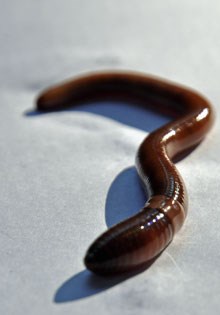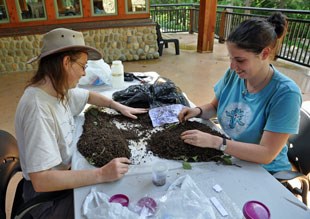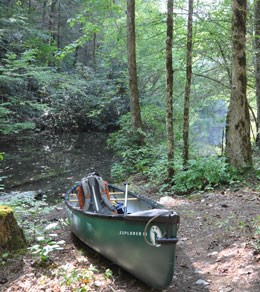|
Non-native Species > Invasive earthworms 
NPS photo. You may know this worm already, although when the Asian Jumping Worm (Amynthas agrestis) is sold for bait or composting as the Alabama Jumper or Georgia Jumper, there is no mention of the destruction it can bring to forests. Composting ads boast that the worm can eat and process more than its body weight in organic matter (vegetable scraps, leaves, lawn trimmings, etc.) each day. That same tenacious appetite means that when people release their bait (or their bait escapes) and the worms make their way to the forest, they consume massive amounts of leaf litter. If you were a leaf-litter-feeder such as a millipede, fly larvae, or springtail, this would be a big problem because your food source would be gone! It would also be bad if you were a creature that ate these invertebrates, if you were a salamander or wildflower tuber that lived in the organic layer of the soil. In some areas on the western side of the Smokies, the Jumping Worm population is so high there is almost no leaf litter left. Without this food, native animals are disappearing, and the nutrients from decaying plants aren’t there to build new soil! 
NPS photo. Which species are the winners and which species are the losers: Anita Juen and Daniela Straube, two scientists from the University of Innsbruck in Austria, conducted a three year study (2010 to 2012) to analyze what these worms are doing to the park’s food web—in this case, if predators change their diet to eat the invasive earthworms. The researchers received funding from the Austrian Science Fund. They collaborated with scientists at the University of Georgia in Athens and the Skidaway Institute of Oceanography in Savannah. Researchers looked for the worm along roads, picnic areas, and parking areas near trailheads, where people and disturbed areas come together. They collected leaf litter and soil samples from all of the study sites and carefully sifted through huge bagfuls with the help of volunteers. Archeologists checked the soil, as well, to ensure the research didn’t disturb artifacts. The researchers picked out all of the living things in the soil, including predators, leaf-litter feeders (also called detritivores), and root feeders for a full census of who lives in the soil. 
NPS photo. The researchers found the invasive Jumping Worm at almost three quarters of their study sites in the Smoky Mountains, which allows them to compare types and numbers of prey species in invaded and non-invaded sites. And they've determined that many of the predatory ground beetles will feed on Jumping Worms, but not all of them can make use of this invasive species as an alternate to their normal prey. In all types of ecosystems—from the soil to the treetops and the seas—we’re finding more invasive, non-native species, and usually we don’t know how they will play a role in the overall food web. Some studies have found huge impacts. In a study in Spain, researchers discovered that native species of tadpoles can’t sense, and therefore can’t escape from, non-native turtles that people introduced. Over time this means that the introduced turtles could eat their fill of tadpoles, depleting the tadpole population (and therefore the frog population, as well), leading to more swarms of insects and a loss of a food source for native turtles. Will something like this happen in the Smokies with the invasive Jumping Worm? We don’t know—but check back for more information. Return to the Non-native Species main page. |
Last updated: October 1, 2018
